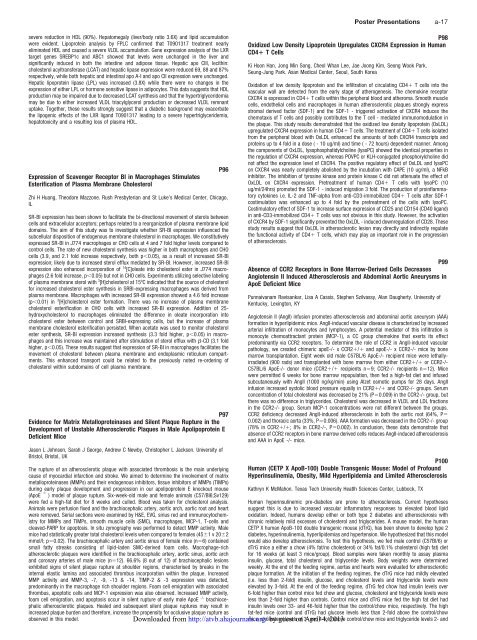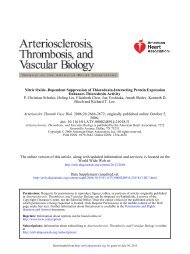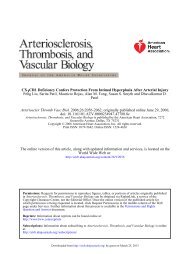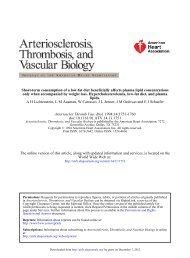Oral Presentations - Arteriosclerosis, Thrombosis, and Vascular ...
Oral Presentations - Arteriosclerosis, Thrombosis, and Vascular ...
Oral Presentations - Arteriosclerosis, Thrombosis, and Vascular ...
Create successful ePaper yourself
Turn your PDF publications into a flip-book with our unique Google optimized e-Paper software.
severe reduction in HDL (90%). Hepatomegaly (liver/body ratio 3.6X) <strong>and</strong> lipid accumulation<br />
were evident. Lipoprotein analysis by FPLC confirmed that T0901317 treatment nearly<br />
eliminated HDL <strong>and</strong> caused a severe VLDL accumulation. Gene expression analysis of the LXR<br />
target genes SREBP1c <strong>and</strong> ABC1 showed that levels were unchanged in the liver <strong>and</strong><br />
significantly induced in both the intestine <strong>and</strong> adipose tissue. Hepatic apo CIII, lecithin:<br />
cholesterol acyltransferase (LCAT) <strong>and</strong> hepatic lipase expression were reduced 69, 88 <strong>and</strong> 87%<br />
respectively, while both hepatic <strong>and</strong> intestinal apo A-I <strong>and</strong> apo CII expression were unchanged.<br />
Hepatic lipoprotein lipase (LPL) was increased (3.8X) while there were no changes in the<br />
expression of either LPL or hormone sensitive lipase in adipocytes. This data suggests that HDL<br />
production may be impaired due to decreased LCAT synthesis <strong>and</strong> that the hypertriglyceridemia<br />
may be due to either increased VLDL triacylglycerol production or decreased VLDL remnant<br />
uptake. Together, these results strongly suggest that a diabetic background may exacerbate<br />
the lipogenic effects of the LXR lig<strong>and</strong> T0901317 leading to a severe hypertriglyceridemia,<br />
hepatotoxicity <strong>and</strong> a resulting loss of plasma HDL.<br />
Expression of Scavenger Receptor BI in Macrophages Stimulates<br />
Esterification of Plasma Membrane Cholesterol<br />
Zhi H Huang, Theodore Mazzone. Rush Presbyterian <strong>and</strong> St Luke’s Medical Center, Chicago,<br />
IL<br />
SR-BI expression has been shown to facilitate the bi-directional movement of sterols between<br />
cells <strong>and</strong> extracellular acceptors; perhaps related to a reorganization of plasma membrane lipid<br />
domains. The aim of this study was to investigate whether SR-BI expression influenced the<br />
subcellular disposition of endogenous membrane cholesterol in macrophages. We constitutively<br />
expressed SR-BI in J774 macrophages or CHO cells at 4 <strong>and</strong> 7 fold higher levels compared to<br />
control cells. The rate of new cholesterol synthesis was higher in both macrophages <strong>and</strong> CHO<br />
cells (3.9, <strong>and</strong> 2.1 fold increase respectively, both p0.05), as a result of increased SR-BI<br />
expression; likely due to increased sterol efflux mediated by SR-BI. However, increased SR-BI<br />
expression also enhanced incorporation of 14 [C]oleate into cholesterol ester in J774 macrophages<br />
(2.6 fold increase, p0.05) but not in CHO cells. Experiments utilizing selective labeling<br />
of plasma membrane sterol with 3 [H]cholesterol at 15 o C indicated that the source of cholesterol<br />
for increased cholesterol ester synthesis in SRBI-expressing macrophages was derived from<br />
plasma membrane. Macrophages with increased SR-BI expression showed a 4.6 fold increase<br />
(p0.01) in 3 [H]cholesterol ester formation. There was no increase of plasma membrane<br />
cholesterol esterification in CHO cells with increased SR-BI expression. Addition of 25hydroxycholesterol<br />
to macrophages eliminated the difference in oleate incorporation into<br />
cholesterol ester between control <strong>and</strong> SRBI-expressing cells, but the increase of plasma<br />
membrane cholesterol esterification persisted. When acetate was used to monitor cholesterol<br />
ester synthesis, SR-BI expression increased synthesis (3.3 fold higher, p0.05) in macrophages<br />
<strong>and</strong> this increase was maintained after stimulation of sterol efflux with -CD (3.1 fold<br />
higher, p0.05). These results suggest that expression of SR-BI in macrophages facilitates the<br />
movement of cholesterol between plasma membrane <strong>and</strong> endoplasmic reticulum compartments.<br />
This enhanced transport could be related to the previously noted re-ordering of<br />
cholesterol within subdomains of cell plasma membrane.<br />
P97<br />
Evidence for Matrix Metalloproteinases <strong>and</strong> Silent Plaque Rupture in the<br />
Development of Unstable Atherosclerotic Plaques in Male Apolipoprotein E<br />
Deficient Mice<br />
Jason L Johnson, Sarah J George, Andrew C Newby, Christopher L Jackson. University of<br />
Bristol, Bristol, UK<br />
The rupture of an atherosclerotic plaque with associated thrombosis is the main underlying<br />
cause of myocardial infarction <strong>and</strong> stroke. We aimed to determine the involvement of matrix<br />
metalloproteinases (MMPs) <strong>and</strong> their endogenous inhibitors, tissue inhibitors of MMPs (TIMPs)<br />
during early plaque development <strong>and</strong> progression in our apolipoprotein E knockout mouse<br />
(ApoE -/- ) model of plaque rupture. Six-week-old male <strong>and</strong> female animals (C57/Bl6;Sv129)<br />
were fed a high-fat diet for 8 weeks <strong>and</strong> culled. Blood was taken for cholesterol analysis.<br />
Animals were perfusion fixed <strong>and</strong> the brachiocephalic artery, aortic arch, aortic root <strong>and</strong> heart<br />
were removed. Serial sections were examined by H&E, EVG, sirius red <strong>and</strong> immunocytochemistry<br />
for MMPs <strong>and</strong> TIMPs, smooth muscle cells (SMC), macrophages, MCP-1, T-cells <strong>and</strong><br />
cleaved-PARP for apoptosis. In situ zymography was performed to detect MMP activity. Male<br />
mice had statistically greater total cholesterol levels when compared to females (451v202<br />
mmol/l; p0.02). The brachiocephalic artery <strong>and</strong> aortic sinus of female mice (n6) contained<br />
small fatty streaks consisting of lipid-laden SMC-derived foam cells. Macrophage-rich<br />
atherosclerotic plaques were identified in the brachiocephalic artery, aortic sinus, aortic arch<br />
<strong>and</strong> coronary arteries of male mice (n12). 66.6% (8 out of 12) of brachiocephalic lesions<br />
exhibited signs of silent plaque rupture at shoulder regions, characterised by breaks in the<br />
internal elastic lamina <strong>and</strong> associated thrombus incorporation within the plaque. Increased<br />
MMP activity <strong>and</strong> MMP-3, -7, -9, -13 & -14, TIMP-2 & -3 expression was detected,<br />
predominantly in the macrophage rich shoulder regions. Foam cell emigration with associated<br />
thrombus, apoptotic cells <strong>and</strong> MCP-1 expression was also observed. Increased MMP activity,<br />
foam cell emigration, <strong>and</strong> apoptosis occur in silent rupture of early male ApoE -/- brachiocephalic<br />
atherosclerotic plaques. Healed <strong>and</strong> subsequent silent plaque ruptures may result in<br />
increased plaque burden <strong>and</strong> therefore, increase the propensity for occlusive plaque rupture as<br />
observed in this model.<br />
Downloaded from<br />
P96<br />
http://atvb.ahajournals.org/<br />
Poster <strong>Presentations</strong> a-17<br />
P98<br />
Oxidized Low Density Lipoprotein Upregulates CXCR4 Expression in Human<br />
CD4 T Cells<br />
Ki Hoon Han, Jong Min Song, Cheol Whan Lee, Jae Joong Kim, Seong Wook Park,<br />
Seung-Jung Park. Asan Medical Center, Seoul, South Korea<br />
Oxidation of low density lipoprotein <strong>and</strong> the infiltration of circulating CD4 T cells into the<br />
vascular wall are detected from the early stage of atherogenesis. The chemokine receptor<br />
CXCR4 is expressed in CD4 T cells within the peripheral blood <strong>and</strong> atheroma. Smooth muscle<br />
cells, endothelial cells <strong>and</strong> macrophages in human atherosclerotic plaques strongly express<br />
stromal derived factor (SDF-1) <strong>and</strong> the SDF-1 - triggered activation of CXCR4 induces the<br />
chemotaxis of T cells <strong>and</strong> possibly contributes to the T cell - mediated immunomodulation in<br />
the plaque. This study results demonstrated that the oxidized low density lipoprotein (OxLDL)<br />
upregulated CXCR4 expression in human CD4 T cells. The treatment of CD4 T cells isolated<br />
from the peripheral blood with OxLDL enhanced the amounts of both CXCR4 transcripts <strong>and</strong><br />
proteins up to 4 fold in a dose (-10ug/ml) <strong>and</strong> time (-72hours) dependent manner. Among<br />
the components of OxLDL, lysophosphatidylcholine (lysoPC) showed the identical properties in<br />
the regulation of CXCR4 expression, whereas POVPC or KLH-conjugated phosphorylcholine did<br />
not affect the expression level of CXCR4. The positive regulatory effect of OxLDL <strong>and</strong> lysoPC<br />
on CXCR4 was nearly completely abolished by the incubation with CAPE (10 ug/ml), a NFkB<br />
inhibitor. The inhibition of tyrosine kinase <strong>and</strong> protein kinase C did not attenuate the effect of<br />
OxLDL on CXCR4 expression. Pretreatment of human CD4 T cells with lysoPC (10<br />
ug/ml/24hrs) promoted the SDF-1 - induced migration 3 fold. The production of proinflammatory<br />
cytokines i.e. IL-2 <strong>and</strong> TNF-alpha from anti-CD3-immobilized CD4 T cells after SDF-1<br />
costimulation was enhanced up to 4 fold by the pretreatment of the cells with lysoPC.<br />
Costimulatory effect of SDF-1 to increase surface expression of CD25 <strong>and</strong> CD154 (CD40 lig<strong>and</strong>)<br />
in anti-CD3-immobilized CD4 T cells was not obvious in this study. However, the activation<br />
of CXCR4 by SDF-1 significantly prevented the OxLDL - induced downregulation of CD28. These<br />
study results suggest that OxLDL in atherosclerotic lesion may directly <strong>and</strong> indirectly regulate<br />
the functional activity of CD4 T cells, which may play an important role in the progression<br />
of atherosclerosis.<br />
P99<br />
Absence of CCR2 Receptors in Bone Marrow-Derived Cells Decreases<br />
Angiotensin II Induced Atherosclerosis <strong>and</strong> Abdominal Aortic Aneurysms in<br />
ApoE Deficient Mice<br />
Punnaivanam Ravisankar, Lisa A Cassis, Stephen Szilvassy, Alan Daugherty. University of<br />
Kentucky, Lexington, KY<br />
Angiotensin II (AngII) infusion promotes atherosclerosis <strong>and</strong> abdominal aortic aneurysm (AAA)<br />
formation in hyperlipidemic mice. AngII-induced vascular disease is characterized by increased<br />
arterial infiltration of monocytes <strong>and</strong> lymphocytes. A potential mediator of this infiltration is<br />
monocyte chemoattractant protein (MCP-1), a CC group chemokine that exerts its effect<br />
predominantly via CCR2 receptors. To determine the role of CCR2 in AngII-induced vascular<br />
pathology, we created chimeric apoE-/- x CCR2/ <strong>and</strong> apoE-/- x CCR2-/- mice by bone<br />
marrow transplantation. Eight week old male C57BL/6 ApoE-/- recipient mice were lethallyirradiated<br />
(900 rads) <strong>and</strong> transplanted with bone marrow from either CCR2/ or CCR2-/-<br />
C57BL/6 ApoE-/- donor mice (CCR2/ recipients n9; CCR2-/- recipients n12). Mice<br />
were permitted 6 weeks for bone marrow repopulation, then fed a high-fat diet <strong>and</strong> infused<br />
subcutaneously with AngII (1000 ng/kg/min) using Alzet osmotic pumps for 28 days. AngII<br />
infusion increased systolic blood pressure equally in CCR2/ <strong>and</strong> CCR2-/- groups. Serum<br />
concentration of total cholesterol was decreased by 21% (P0.009) in the CCR2-/- group, but<br />
there was no difference in triglycerides. Cholesterol was decreased in VLDL <strong>and</strong> LDL fractions<br />
in the CCR2-/- group. Serum MCP-1 concentrations were not different between the groups.<br />
CCR2 deficiency decreased AngII-induced atherosclerosis in both the aortic root (64%, P<br />
0.002) <strong>and</strong> thoracic aorta (33%, P0.006). AAA formation was decreased in the CCR2-/- group<br />
(78% in CCR2/; 8% in CCR2-/-, P0.002). In conclusion, these data demonstrate that<br />
absence of CCR2 receptors in bone marrow derived cells reduces AngII-induced atherosclerosis<br />
<strong>and</strong> AAA in ApoE -/- mice.<br />
P100<br />
Human (CETP X ApoB-100) Double Transgenic Mouse: Model of Profound<br />
Hyperinsulinemia, Obesity, Mild Hyperlipidemia <strong>and</strong> Limited Atherosclerosis<br />
Kathryn K McMahon. Texas Tech University Heatlh Sciences Center, Lubbock, TX<br />
Human hyperinsulinemic pre-diabetes are prone to atherosclerosis. Current hypotheses<br />
suggest this is due to increased vascular inflammatory responses to elevated blood lipid<br />
oxidation. Indeed, humans develop either or both type 2 diabetes <strong>and</strong> atherosclerosis with<br />
chronic relatively mild excesses of cholesterol <strong>and</strong> triglycerides. A mouse model, the human<br />
CETP X human ApoB-100 double transgenic mouse (dTrG), has been shown to develop type 2<br />
diabetes, hyperinsulinemia, hyperlipidemias <strong>and</strong> hypertension. We hypothesized that this model<br />
would also develop atherosclerosis. To test this hypothesis, we fed male control (C57Bl/6) or<br />
dTrG mice a either a chow (4% fat/no cholesterol) or 34% fat/0.1% cholesterol (high fat) diet<br />
for 16 weeks (at least 3 mice/group). Blood samples were taken monthly to assay plasma<br />
insulin, glucose, total cholesterol <strong>and</strong> triglyceride levels. Body weights were determined<br />
weekly. At the end of the feeding regime, aortas <strong>and</strong> hearts were evaluated for atherosclerotic<br />
plaque formation. At the initiation of the feeding regimes, the dTrG mice had mildly elevated<br />
(i.e. less than 2-fold) insulin, glucose, <strong>and</strong> cholesterol levels <strong>and</strong> triglyceride levels were<br />
elevated by 3-fold. At the end of the feeding regime, dTrG fed chow had insulin levels over<br />
6-fold higher than control mice fed chow <strong>and</strong> glucose, cholesterol <strong>and</strong> triglyceride levels were<br />
less than 2-fold higher than controls. Control mice <strong>and</strong> dTrG mice fed the high fat diet had<br />
insulin levels over 33- <strong>and</strong> 46-fold higher than the control/chow mice, respectively. The high<br />
fat-fed mice (control <strong>and</strong> dTrG) had glucose levels less than 2-fold above the control/chow<br />
mice, cholesterol by guest levelson of 3- April <strong>and</strong> 4-fold 4, 2013 above control/chow mice <strong>and</strong> triglyceride levels 2- <strong>and</strong>














